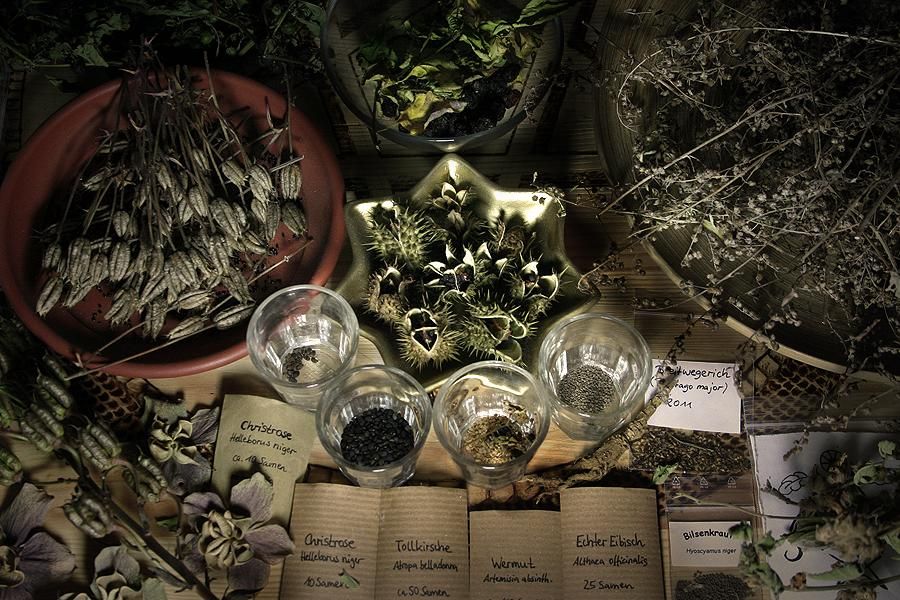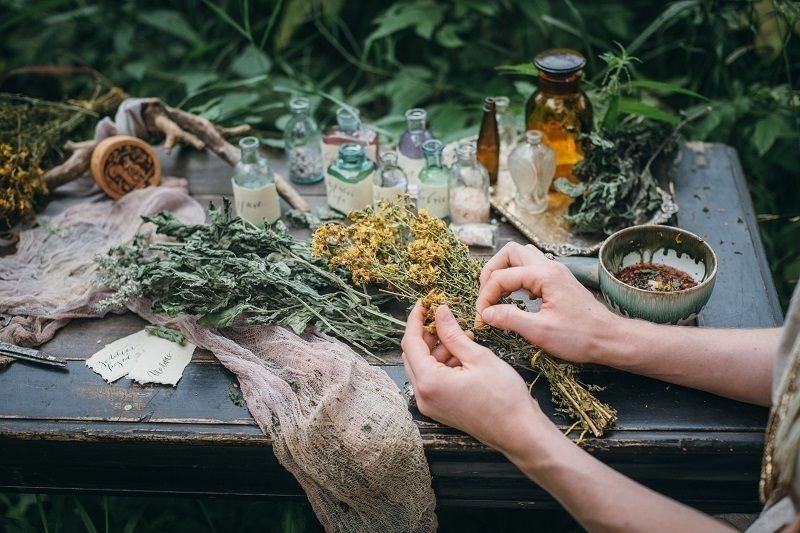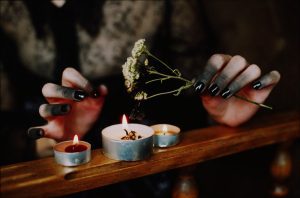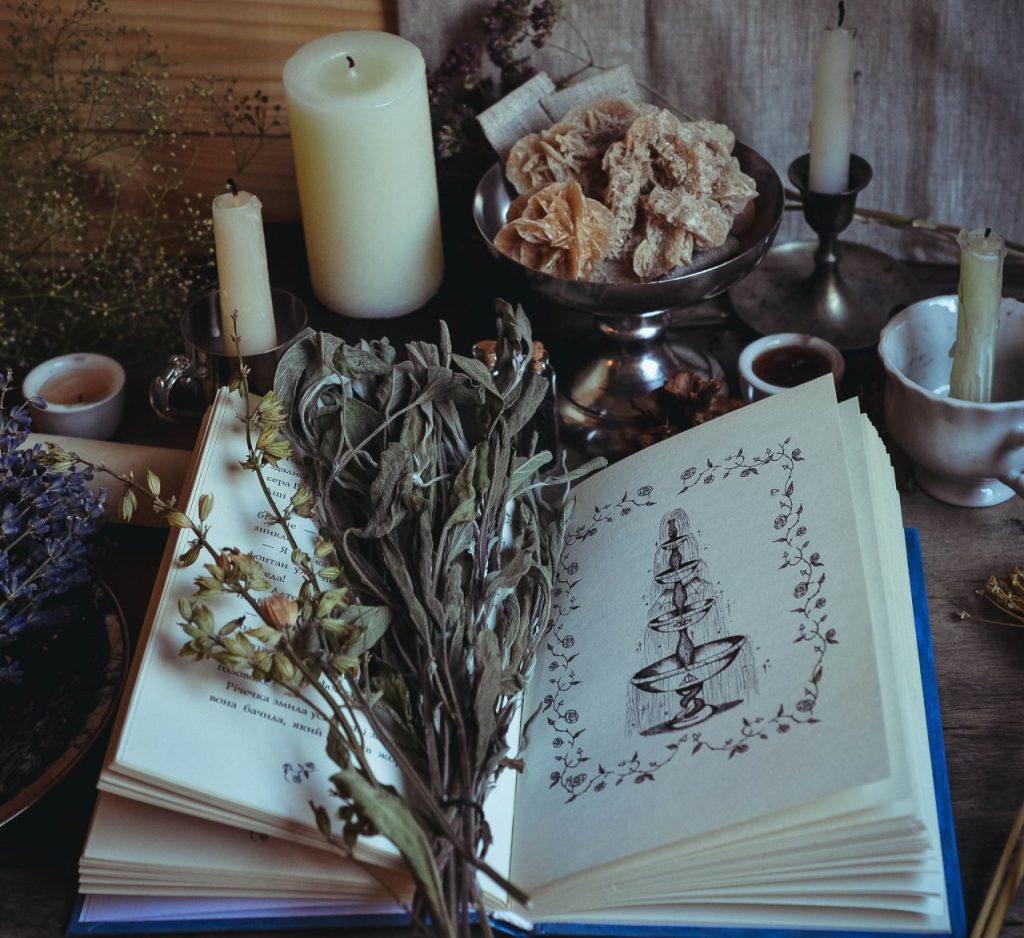Herbs for witchcraft have held a sacred place throughout history, revered for their mystical properties and their vital role in the practice of magic. For millennia, wise practitioners have sought to tap into the natural energies of these potent plants, harnessing their spiritual, healing, and transformative powers. Whether you are an experienced witch or a curious novice, incorporating herbs into your magical workings can deepen your connection with nature and amplify the potency of your spells. In this article, in Witch Symbols we will explore the fascinating world of herbs for witchcraft, uncovering the magical associations of some commonly used herbs.


1-Lavender (Lavandula angustifolia)
Lavender is one of the most popular and versatile herbs for witchcraft. Its delightful fragrance, vibrant purple flowers, and various magical properties make it a valuable ally for witches and practitioners of the craft. Here’s everything you need to know about lavender and its role as a herb for witchcraft:
Magical Properties of Lavender
- Purification and Cleansing: Lavender is well-known for its purifying properties. In witchcraft, it is often used to cleanse spaces, objects, and even individuals of negative energies and influences. Smudging with lavender, similar to the Native American practice of using sage, can help clear away stagnant energies and promote a sense of renewal.
- Peace and Relaxation: In herbs for witchcraft, the soothing aroma of lavender is renowned for its calming effects. It can be used in spells and morning rituals to promote relaxation, reduce stress, and bring about a sense of peace. Lavender-infused baths, sachets, or pillows are common ways to harness its tranquility-inducing qualities.
- Protection: Lavender is believed to possess protective energies that can shield individuals and spaces from harm. Placing bundles of dried lavender or sachets filled with its flowers around the home can create a protective barrier against negative influences.
- Love and Romance: Amidst the realm of herbs for witchcraft, lavender stands out as an ideal and enchanting selection as a herb for love spells and rituals. Blessed with a sweet scent and deeply connected to tranquility, this herb infuses matters of the heart with mystical allure. Within lavender’s alluring essence lies the power to attract love, fortify romantic bonds, and cultivate feelings of affection and harmony in the hearts of those who embrace its magical touch. When seeking to weave love spells and kindle passion, lavender’s mystical embrace becomes an invaluable aid in the art of enchantment.
- Sleep and Dreams: Other than its effective role in herbs for witchcraft, lavender is also widely used to improve sleep quality and encourage restful slumber. Placing lavender sachets under the pillow or using lavender essential oil in a diffuser before bedtime can promote peaceful and vivid dreams
- Divination and Psychic Abilities: Lavender is believed to heighten psychic awareness and intuition. It is one of the most frequently used herbs for witchcraft in rituals and practices related to divination, meditation, and spiritual growth.
Ways to Use Lavender in Witchcraft
- Incense: Burning dried lavender as incense is a common way to infuse your sacred space with its magical properties. The smoke can purify the area and create a serene atmosphere conducive to meditation and spellwork.
- Essential Oil: Lavender is one of the most powerful herbs for witchcraft if used as an essential oil. You can anoint candles, ritual tools, or yourself with lavender oil to amplify your intentions and enhance your magical workings.
- Potpourri and Sachets: Create potpourri or sachets filled with dried lavender flowers to place around your home, in your car, or carry with you to harness its protective and calming energies throughout the day.
- Bath Rituals: Adding dried lavender or lavender essential oil to your bathwater can create a soothing and magical experience. Visualize the water cleansing your aura and renewing your energy as you soak.
- Spellwork: Lavender can be incorporated into various spellwork, such as protection spells, love spells, and divination rituals. Combine lavender with other herbs for witchcraft and elements that align with your intentions to enhance the potency of your spells.
Lavender is one of the most valued herbs for witchcraft due to its diverse and potent magical properties. From purifying spaces to promoting peace, love, and divination, lavender has been a treasured ally to witches and practitioners for centuries. When working with lavender in your magical practices, remember to do so with respect, gratitude, and a clear intention to harness its true potential as a mystical and enchanting herb.
2-Sage (Salvia officinalis)
Sage (Salvia officinalis) is a popular and revered herb in the world of witchcraft due to its potent and versatile magical properties. This sacred plant has a long history of use in various cultural and spiritual practices and has become an essential tool for many witches and practitioners of the craft. Here’s everything you need to know about sage and why it’s considered one of the popular herbs for witchcraft:
Magical Propreties of Sage
- Cleansing and Purification: Sage is perhaps most well-known in the world of herbs for witchcraft due to its powerful cleansing and purifying properties. It is used to clear negative energy and dispel stagnant or malevolent forces from spaces, objects, and individuals. This practice is known as smudging, where dried sage bundles are burned, and the smoke is wafted around to purify the surroundings.
- Protection: Same as other herbs for witchcraft such as lavender, sage is believed to have strong protective energies as well , making it a valuable herb in warding off negativity and creating a shield against unwanted influences. Placing bundles of sage leaves or sachets with dried sage around one’s home or sacred space is a common way to enhance protective energies.
- Wisdom and Clarity: In witchcraft, sage is associated with wisdom and clarity of mind. Burning sage or using its essential oil can be used to promote mental focus, clear thinking, and aid in decision-making processes.
- Healing and Health: In addition to other herbs for witchcraft, sage has also been used for centuries for its medicinal properties. In magical practices, it is often employed to support healing rituals and to promote overall well-being. Some believe that the smoke from burning sage can have healing effects on the physical and energetic body.
- Spirituality and Divination: Sage is considered one of the sacred herbs for witchcraft used in various spiritual traditions. It is used to purify and consecrate tools, such as crystals, tarot cards, or wands, before magical workings or divination practices.
- Transformation and New Beginnings: Sage is associated with transformation and new beginnings. It is often used in rituals to mark significant life events, such as moving into a new home, starting a new chapter in life, or embarking on a fresh spiritual journey.
- Ancestral Connection: In some practices, sage is used to honor and communicate with ancestors and spirits. Burning sage during ancestor veneration rituals can serve as a bridge between the physical and spiritual realms.
Ways to Use Sage in Witchcraft
Sage can be used in various forms in witchcraft, including dried bundles for smudging, loose leaves for burning as incense, essential oils for anointing tools or candles, or as an ingredient in magical potions and spells.
As one of the popular herbs for witchcraft, sage is highly esteemed and held in deep respect in various spiritual practices and traditions. Its ability to purify, protect, and enhance spiritual practices has solidified its position as a beloved and indispensable herb in the craft.
3-Rosemary (Rosmarinus officinalis)
Rosemary (Rosmarinus officinalis) is a versatile and cherished herb with a rich history in both culinary and magical practices. Its aromatic leaves and woody scent have made it a popular choice in witchcraft for centuries. Here’s why it’s included in herbs for witchcraft:
Magical Propreties of Rosemary and How to Use it
- Protection: Rosemary is known for its potent protective properties. In witchcraft, it is often used to create protective barriers, ward off negative energies, and guard against evil spirits. Placing dried rosemary sprigs around the home or carrying a small sachet of dried leaves can help establish a protective aura.
- Purification and Cleansing: Rosemary is considered one of the herbs for witchcraft used for cleansing and purifying spaces and objects. Burning dried rosemary as incense or using rosemary-infused water in a cleansing ritual can clear away negative energy and promote a sense of renewal.
- Memory and Mental Clarity: Rosemary is associated with memory enhancement and mental clarity. It is believed that using rosemary in rituals or carrying a small sprig can stimulate mental focus, improve memory retention, and aid in concentration during divination practices.
- Love and Attraction: Similar to other herbs for witchcraft, rosemary can be employed in love spells and rituals to attract affection and romantic love. It is thought to enhance feelings of love, strengthen relationships, and bring harmony to partnerships.
- Protection During Dreamwork: Placing rosemary under the pillow or creating a “dream pillow” with dried rosemary can provide protection during dreamwork and encourage prophetic dreams.
- Prosperity and Abundance: Some practitioners believe that incorporating herbs for witchcraft such as rosemary into money and abundance spells can attract prosperity and good fortune.
- Spiritual Growth: Rosemary is thought to aid in spiritual growth and self-awareness. It can be used in meditation practices to facilitate inner exploration and enhance one’s connection with the spiritual realm.
Incorporating Rosemary into witchcraft rituals and practices allows witches to tap into its multifaceted magical properties. Whether it’s for protection, purification, love, healing, or spiritual growth, Rosemary is a cherished and essential herb in the craft, carrying with it centuries of folklore and mystique.


4-Mugwort (Artemisia vulgaris)
Mugwort (Artemisia vulgaris) is a versatile herb, likewise other herbs for witchcraft, that can be used for multiple purposes such as divination, dream work, spiritual growth, and psychic abilities. It has a long history of use in various cultures, including Chinese, Korean, and Japanese traditional medicine.
Mugwort is a perennial plant that grows up to 6 feet tall and is commonly found in Asia, Europe, and North America. It has a woody stem, gray-green leaves, and small yellow flowers that bloom in the summer. The leaves and flowers of the plant are used for medicinal and magical purposes.
Magical Properties of Mugwort
Mugwort is known for its powerful magical properties, which include:
- Divination: Mugwort is often used in divination rituals, included with other herbs for witchcraft to enhance psychic abilities and promote clairvoyance. It is believed that burning mugwort as incense or drinking it as tea before divination can help you connect with your intuition and receive messages from the spirit world.
- Dream work: Mugwort is commonly used in dream work to promote vivid and prophetic dreams. It is believed that placing mugwort under your pillow or burning it as incense before sleep can enhance your dream recall and help you receive messages from the spirit world.
- Spiritual growth: Mugwort is used in spiritual growth rituals to enhance spiritual awareness and promote inner vision. It is believed that burning mugwort as incense or drinking it as tea can help you connect with the spiritual realm and receive guidance from your higher self.
- Protection: Mugwort is known for its protective properties. It is often used in protection spells or carried in a sachet to repel negative energies and promote spiritual cleansing.
- Fertility: Mugwort is believed to be a powerful fertility herb. It is often used in fertility spells or carried in a sachet to enhance fertility and promote healthy pregnancies.
How to Use Mugwort in Witchcraft
Like many other herbs for witchcraft, mugwort is a versatile herb with a wide range of ways to use it, including:
- Burning mugwort as incense: You can burn dried mugwort leaves as incense to enhance psychic abilities, promote vivid dreams, and protect your home from negative energies.
- Drinking mugwort tea: You can brew dried mugwort leaves in hot water to make a tea that can help enhance psychic abilities, promote vivid dreams, and promote spiritual growth.
- Placing mugwort under your pillow: Placing dried mugwort leaves under your pillow before sleep can promote vivid and prophetic dreams.
- Carrying mugwort in a sachet: You can carry dried mugwort leaves, either alone or in combination with other herbs for witchcraft, in a sachet to ward off negative energies, promote spiritual cleansing, and enhance fertility.
- Using mugwort in a bath: You can add dried mugwort leaves to your bathwater with essential oils from different herbs for witchcraft, to promote spiritual cleansing, enhance psychic abilities, and promote relaxation.
Overall, mugwort is a powerful herb with many magical properties that can enhance your spiritual practice. As with other herbs for witchcraft, it is important to research and understand its properties before using it in spells and rituals.
5-Chamomile (Matricaria chamomilla)
Chamomile, also known as Matricaria chamomilla or German chamomile, is a popular herb that has been used for various purposes throughout history. It is a member of the daisy family (Asteraceae) and is native to Europe and Western Asia. Chamomile has delicate, white, daisy-like flowers with a yellow center and a pleasant, apple-like aroma. There are two common types of chamomile used for herbal purposes: German chamomile (Matricaria chamomilla) and Roman chamomile (Chamaemelum nobile). Both varieties are part of herbs for witchcraft that can also be used in traditional medicine.
In herbal medicine, chamomile is well-known for its potential health benefits, and it has been used for centuries to treat a variety of ailments. Some of its common uses include:
- Relaxation and stress relief: Chamomile can help promote relaxation, and improve sleep quality.
- Digestive aid: It is commonly consumed as a tea to alleviate digestive issues.
- Anti-inflammatory properties: Chammomile can help soothe skin irritations and minor wounds.
- Antioxidant effects: Chamomile contains antioxidants that may help protect the body from oxidative stress and cellular damage.
- Menstrual discomfort: Chamomile tea is often used to ease menstrual cramps and relieve tension during the menstrual cycle.
Now, let’s explore why chamomile is considered a significant herb for witchcraft and magical practices:
1-Correspondences : In magical traditions, herbs for witchcraft are often associated with specific correspondences, such as planets, elements, and zodiac signs. Chamomile is associated with the Sun and the element of Water, making it suitable for spells and rituals related to abundance, prosperity, purification, and emotional healing.
2-Cleansing and Purification: Chamomile is believed to have purifying properties, both for physical spaces and energetic cleansing. It can be used to cleanse ritual tools, create sacred spaces, or add to bathwater for a spiritual cleanse.
3-Healing and Protection: sSince it is considered a medicinal herb and a herb for witchcraft as well, chamomile is often used in magical practices related to healing and protection. It can be incorporated into charms, sachets, or spell bags for promoting physical and emotional healing and warding off negative energies.
4-Dreamwork and Sleep: Chamomile’s reputation as a relaxant and sleep aid also extends to its magical properties. It is frequently used in dream pillows, sachets, or tea blends to enhance dreams, promote restful sleep, and aid in dreamwork or divination.
5-Love and Luck: Chamomile is sometimes associated with attracting love and luck. It can be used in love spells or rituals to bring harmony and affection into one’s life.
6-Connection to Nature: As a beautiful and fragrant flower, chamomile is considered to have a strong connection to nature and the spirits of the plant realm. This connection can be harnessed in rituals for nature-based or earth-centered spirituality.
6- Basil (Ocimum basilicum)
Basil (Ocimum basilicum) is a popular culinary herb with a long history of medicinal and magical uses. It belongs to the Lamiaceae family and is native to regions in Asia and Africa. Basil is known for its distinctive aroma and flavor, which varies depending on the variety, with the most common being sweet basil.
In addition to its culinary applications, basil has been revered in various cultures for its medicinal properties, including anti-inflammatory, antibacterial, and antioxidant effects. It contains essential oils like eugenol and linalool, which contribute to its aromatic and therapeutic qualities. The herb is commonly used in traditional medicine to address digestive issues, respiratory problems, and stress-related conditions.
As a popular herb for witchcraft, basil holds significant symbolism and is associated with various magical properties. Here’s how basil is used in witchcraft:
1- Protection: Basil is often used for protection spells and rituals to ward off negative energies, malevolent spirits, or harmful intentions. It can be worn as an amulet, placed in a sachet, or hung at doorways and windows to create a protective barrier around the home.
2- Purification: Among other herbs for witchcraft, basil is considered a purifying herb that can cleanse spaces, objects, and individuals from negative energies or influences. Burning dried basil leaves as incense or sprinkling basil-infused water can be part of purification rituals.
3-Love and Relationships: Basil is associated with love and romance. It can be used in spells or charms to attract love, enhance existing relationships, or promote harmony between partners. One common practice is to write a love letter to a desired partner on a basil leaf and then burn it as an offering to the spirits.
4-Wealth: Herbs for witchcraft are sometimes used in rituals and spells aimed at attracting wealth, success, and abundance. Basil can be carried in a sachet or charm bag or placed in a money jar or on a money altar to help manifest financial success.
5-Spiritual Connection: Basil is considered a sacred herb for witchcraft therefore it is used to enhance meditation and facilitate spiritual growth. The herb’s uplifting aroma is thought to help raise vibrations and foster a deeper connection with the divine.
6-Ancestor and Spirit Work: In certain traditions, basil is offered as a token of respect and honor to ancestors and spirits during rituals and offerings.


Healing using Herbs for Witchcraft
Healing using herbs for witchcraft is a practice that dates back to ancient times when natural remedies and plant-based medicine were the primary means of treating ailments. In modern witchcraft, herbs continue to hold a significant role in healing rituals and practices, with a focus on holistic well-being and the integration of mind, body, and spirit.
A-Herbal Medicine
Witches often utilize various herbs with known medicinal properties to create herbal remedies. These remedies can be in the form of teas, tinctures, salves, oils, or poultices, each crafted with specific herbs tailored to address particular health concerns. Herbal medicine in witchcraft is believed to work on both physical and energetic levels, supporting the body’s natural healing processes.
B-Energy Healing
Herbs for witchcraft are also used in energy healing practices. They are believed to carry unique energetic vibrations that can influence the body’s subtle energy systems. By working with herbs and their associated energies, witches aim to bring balance and harmony to the physical, emotional, and spiritual aspects of a person, promoting overall well-being.
C-Ritual and Intent
Healing rituals in witchcraft often involve the use of specific herbs for witchcraft to amplify the intentions and focus the energy of the practitioner. Through these rituals, the witch may direct healing energies to themselves, others, or the environment. By incorporating specific healing herbs, the practitioner seeks to harness their medicinal and spiritual properties to facilitate the healing process.
D- Ancestral Knowledge
In many witchcraft traditions, healing using herbs is deeply connected to ancestral knowledge and practices. Witches may draw upon the wisdom passed down through generations to understand the healing properties of different herbs and how they can be effectively utilized for specific ailments.
E- Self-Care and Empowerment
Healing with herbs for witchcraft is not limited to treating physical ailments but also extends to emotional and mental well-being. The practice emphasizes self-care and empowerment, encouraging individuals to take an active role in their healing journey by working with witch herbs, connecting with nature, and nurturing their spiritual selves.


Final Thoughts
Incorporating herbs into your witchcraft practice can be a profound way to connect with nature’s energies and deepen your magical endeavors. The herbs mentioned above are just a few examples of the vast array of plants available to witches seeking to enhance their craft. Remember to approach working with herbs with respect, understanding, and knowledge. Explore the folklore, history, and traditional uses of each herb to gain a deeper appreciation for its magical properties. By embracing the power of herbs in your witchcraft, you embark on a journey of ancient wisdom and spiritual growth, connecting with the natural world and your inner magic.


Pingback: 10 Spring Equinox Rituals to Welcome the New Season - Witch Symbols
Pingback: Aissa (aissabuter) | Pearltrees
Pingback: Herbs for Witchcraft: Enhancing Your Magical Pr...
Pingback: Witch Symbols & Meanings | Explore Wiccan & Pagan Magic
Pingback: Witch Symbols & Meanings | Explore Wiccan & Pagan Magic